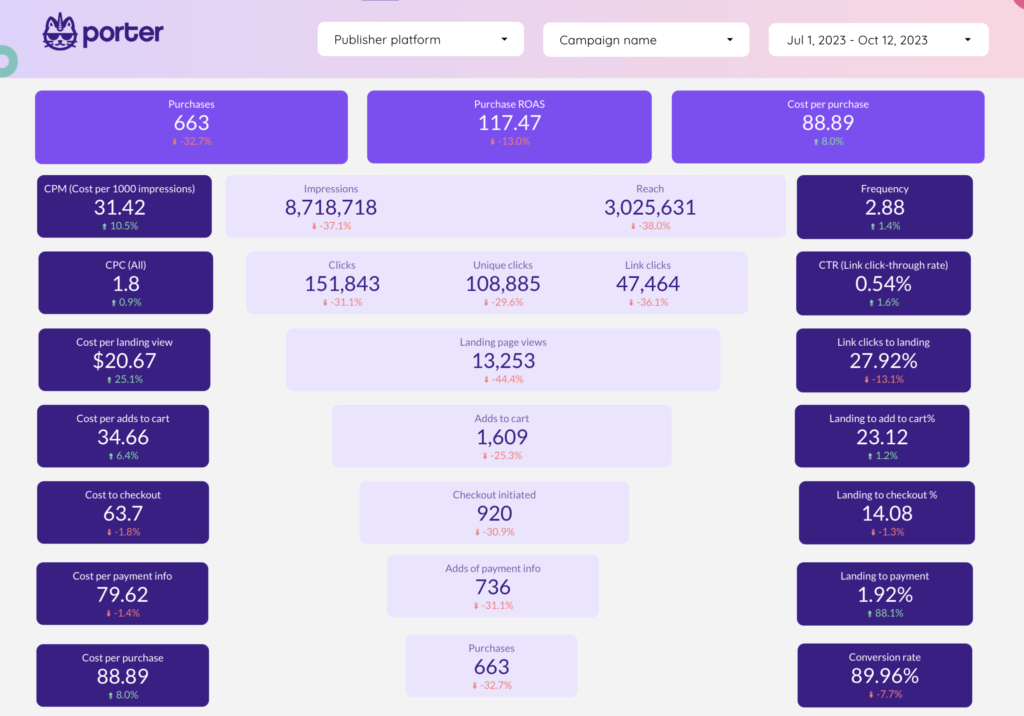To connect Google Analytics 4 to Google Looker Studio (formerly Data Studio), go to Create report (or to the Looker Studio community connectors gallery), choose the Google Analytics 4 integration by Porter Metrics, connect your Google account, connect your Google Analytics properties, see the list of fields available, and generate a default report template to monitor your performance and automate your marketing reports.
By the end of the tutorial, you’ll know:
- 3 free and paid ways to connect Google Analytics 4 to Looker Studio
- Customize your Google Analytics 4 reports
- Available Google Analytics 4 metrics and dimensions
- Custom Google Analytics 4 metrics and dimensions
- Free Google Analytics 4 Report templates for Google Looker Studio
Free and paid ways to connect Google Analytics 4 to Looker Studio
You can connect Google Analytics 4 to Looker Studio through a connector (suggested for this tutorial), or importing data first to a Google Sheet automatically or manually.
As an additional resource, learn to connect any data to Looker Studio, or, if you present any problems during the setup, go to our troubleshooting guide.
Google Analytics 4 connector for Looker Studio
The advantage of using a direct connector is that you can create charts by freely combining metrics and dimensions, without managing queries or Sheets in between, making it faster and easier to build reports.
In a nutshell, follow these steps when using a Google Analytics 4 connector for Looker Studio.
Go to the Porter Metrics onboarding or the Google Looker Studio connectors gallery and choose the Google Analytics 4 connector (by Porter).
Connect the same Google account you’re using on Google Looker Studio.
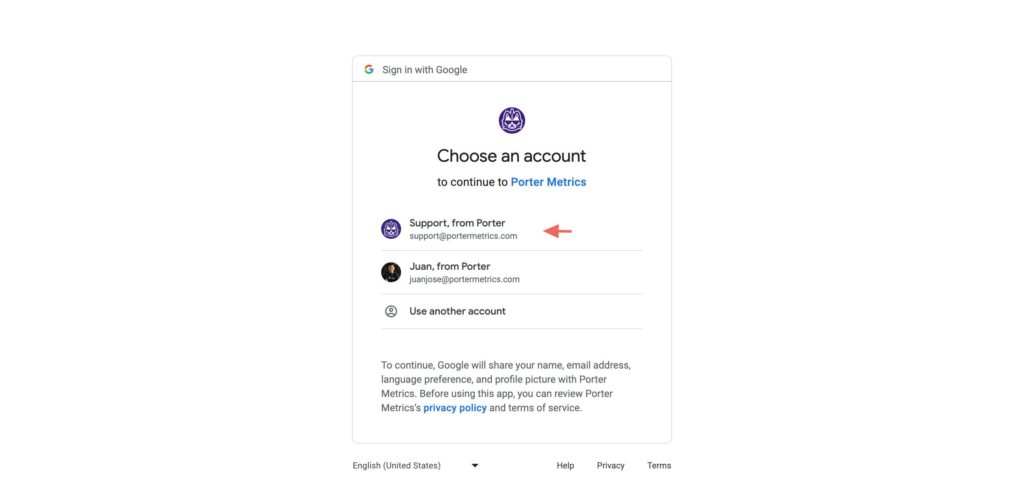
Click on Authorize to connect Porter and Google.
Connect the Google account with access to your GA4 properties.

Optionally, connect other Google accounts to connect other Google Analytics 4 properties and views your Google email doesn’t have access to.
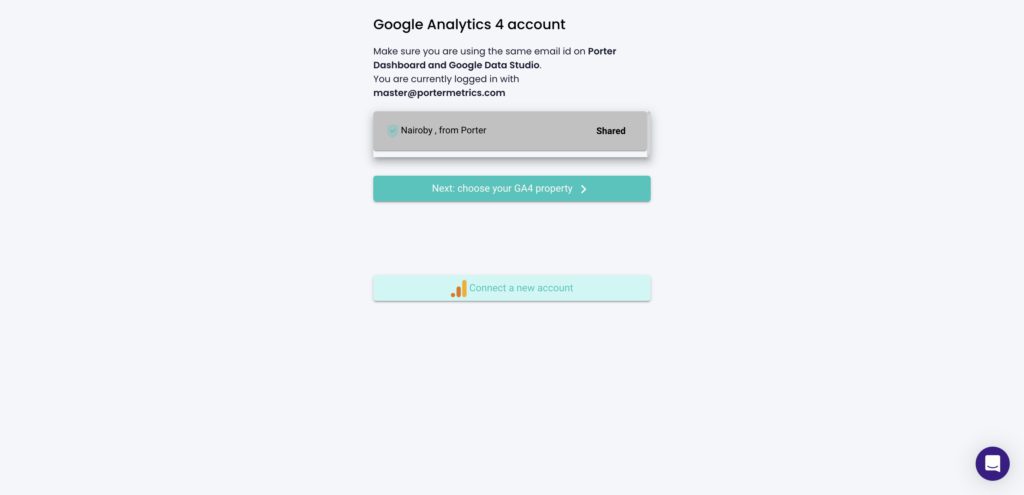
Close the authentication popup and go back to Looker Studio.
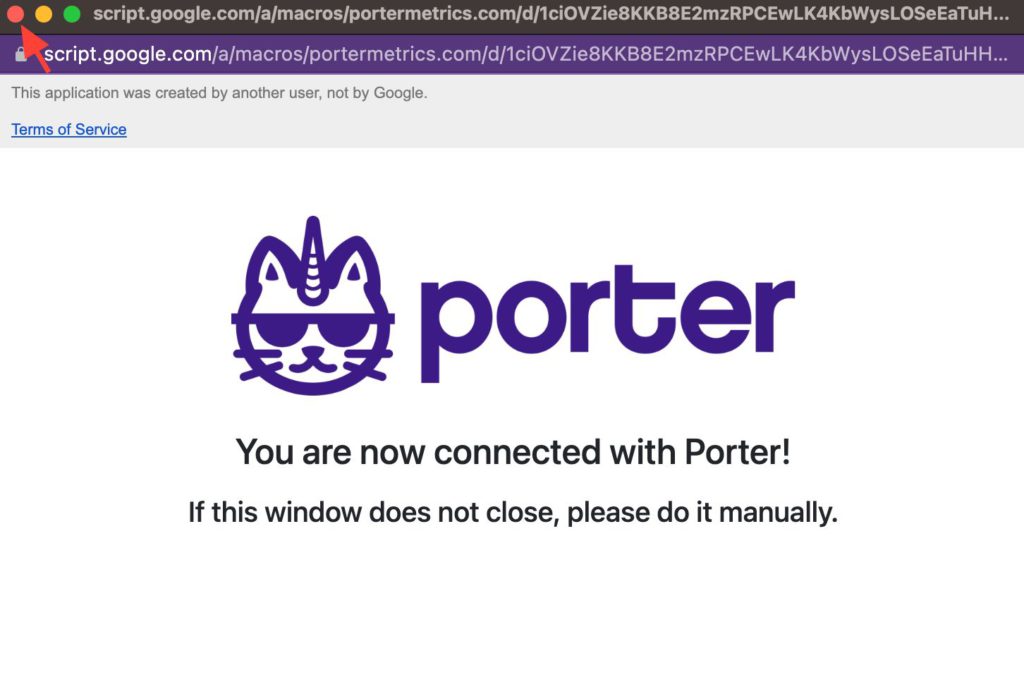
Define one or more Google Analytics accounts (or views) you want to visualize on your report.
See the fields and go to Create report.

Download our free Google Analytics 4 report template for Looker Studio, and start a 14-day free trial:
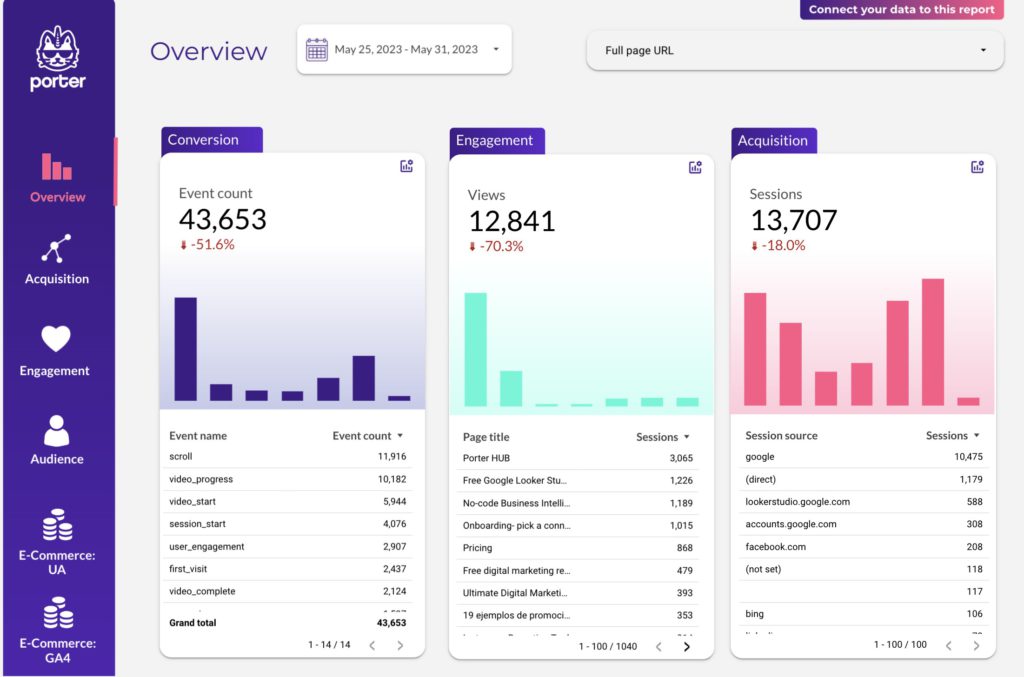
Importing Google Analytics 4 data on Google Sheets
The advantage of using Google Sheets as integration is instant load time when querying small amounts of data, and guaranteed stability, as you’re using Google’s native integrations.
With Sheets, also, you can edit your data. For instance, you could set goals, agency markups or commissions.
As a downside, connecting to Google Sheets first hinders the use of templates and removes data granularity (i.e. freely combining metrics and dimensions when creating charts).
Use the Porter Metrics Google Sheets add-on to automatically import your Google Analytics data on a Google Sheet to later connect that Google Sheet to a Looker Studio report.
Uploading a CSV file
As a free option, manually download your Google Analytics 4 data as a CSV file and import it on a Google Sheet, but:
- Data won’t refresh and update automatically
- Up to100 uploads
- Max 100MB per CSV
- All CSV files structure must be identical
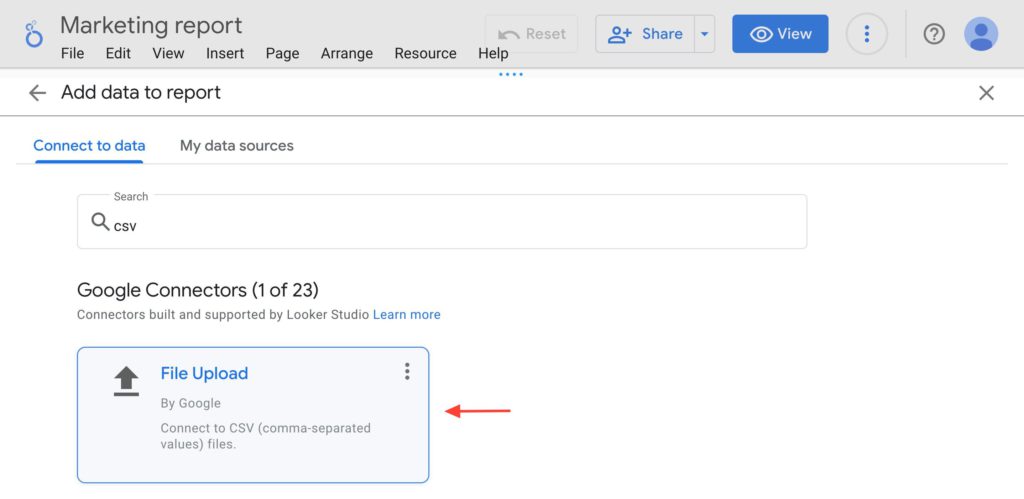
Customize your Google Analytics 4 reports
To continue with the report setup, you can add a new page on the report template just downloaded, or create a new report from scratch, and go to the Edit view.
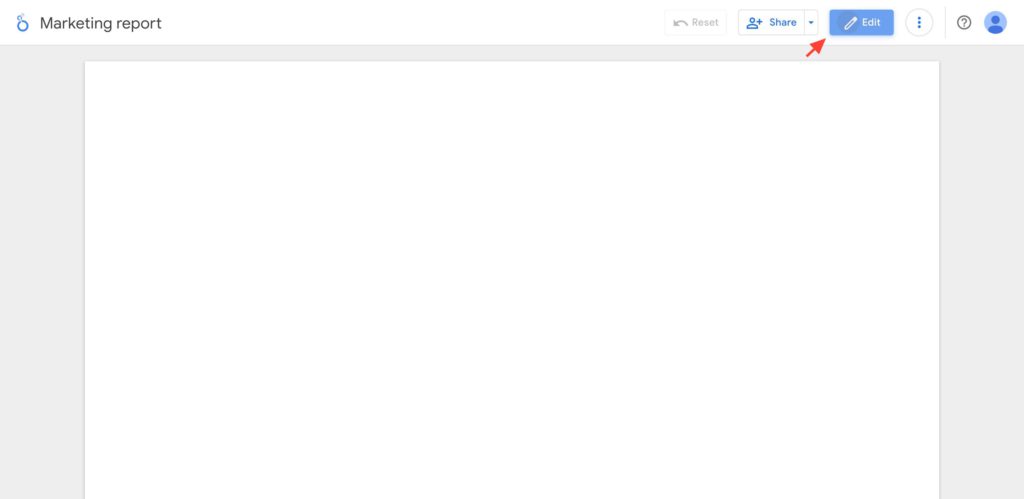
If you opt to create a new report, here’s how to connect again your data on Looker Studio.
Adding charts
Add scorecards, time series, tables, pie charts, and more chart types to visualize your data.
Scorecards
Scorecards are the most simple way to display your data, by only showing a metric.
Go to Insert, choose a scorecard, and paste it in the canvas.
We’ll use Sessions as the metric that corresponds to the traffic reported on GA4. Optionally, you could also use Total users.
Create 2 more scorecards by repeating the process or copy-pasting the original scorecard.
Optionally, use Total users and Event count, or +200 fields available on the GA4 API, including conversions and e-commerce.
Time series
Time series charts are useful to visualize trends over time.
Go to Insert – Time series.
Use date as date dimension. Use Sessions as the metric.
Optionally, use other date dimensions like month, week, day of week.
Tables
Tables are the most flexible and complete way to visualize data, letting you add as many metrics and dimensions as you want.
Go to Insert – Table.
Use Source and Medium as dimension; Use Sessions and total users as the metrics.
You can also create a separate table where you break down your data by Page title to see what content is driving the most traffic or conversions.
Bar charts, pie charts, and maps
Both bar charts and pie charts let you visualize your data by breakdowns. Bar charts are better for cardinal and ordinal data; pie charts are better for nominal data.
Go to Insert – Pie chart.
- For the bar chart, use Device as the dimension.
- For the pie chart, use Gender as the dimension.
- For the map, use City as the geo dimension.
As metrics use Sessions, Users, or any other metric. Consider that your charts may break if the combination of metrics and dimensions are invalid. For instance, you may not combine Users with Session source, you’d need to use Sessions instead.
Comparisons
Add goals, reference lines, or conditional formats to compare your data and add context.
Comparison date range
Select the scorecards and set Previous Period as the comparison date range.
Reference lines
Select the time series Go to Style – Add a Reference line, choose Metric as type, and Average, as aggregation.
Conditional formatting
Select the time series Go to Style – Conditional formatting, choose Color scale and any metric.
Adding controls
Use dropdowns, search bars, data range controls, or parameters to make your reports interactive by applying filters. Learn more about controls.
Date range controls
Go to Add a control – Dropdown. Choose Date range control to visualize your marketing data daily, weekly, monthly, etc.
Dropdowns
Go to Add a control – Dropdown. Choose Page title as the dimension.
Design
To influence your team or clients, design and white-label your marketing dashboards. Also, follow our recommendations on designing marketing reports.
Shapes
Use rectangles or circles to draw sections or headers. Right-click the rectangle – Order – Send to back.
Text
Use text to add headers, chart titles, or complementary analysis or comments to your charts.
Go to Text on the Looker Studio menu and paste it in the header of the report. Customize the font family and size.
Colors
Customize the colors of every single chart.
Select the scorecard and go to Style. Change the value size, colors, backgrounds, and borders.
Optionally, select and copy a chart, and copy-paste its style in another chart with right-click – paste special – Paste style only.
Logo
Change the current logo or add your own by choosing Image and uploading a PNG file.
Theme and layout
Change your report’s canvas size, navigation menu, background colors, and default charts’ style.
To customize the theme, go to Theme and Layout – Theme. Choose one of the default templates or customize it.
To customize the layout, go to Theme and Layout – Layout.
- View mode: set the header visibility to Initially hidden; set the navigation type to the left; and set the mode to fit to width and remove the margin to make your report mobile-friendly.
- Canvas size: we’d suggest 1024×768 for a slide view, or 900×1200 for a vertical view.
Navigation
You can create multiple pages for your report, divide them by sections, and add icons.
Go to Page – New page. On Page settings, you can do any customization at a page level, without impacting the whole report.
Share
Share your Google Looker Studio reports with an audience through permissions, links, embeds, PDF, or email schedules.
Permissions
Grant editor or viewer permissions to users with Google accounts within or outside your company.
Schedule delivery
To schedule an automatic report delivery, go to Share – Schedule delivery.
Set the subject, recipients, pages, filters, start date, and frequency to send your reports via email.
Download PDF
Download a PDF version of your reports and, optionally, exclude pages.
We encourage you to take our Google Looker Studio tutorial for marketers and learn to present your marketing reports.
Google Analytics 4 metrics and dimensions
As reference, see the Google Analytcs 4 fields list and suggestions for choosing GA4 KPIs.
The Google Analytics 4 connector for Google Looker Studio offers all the +200 metrics and dimensions available on the Google Analytics API, including all custom events and conversions.
Google Analytics 4 dimensions
To monitor your Google Analytics 4 performance, break down your data by dimensions.
The most common ways to break down your marketing data are by:
- Over time: for hourly, daily, weekly, monthly, quarterly, and annual reporting
- Account: break down by client, if you’re an agency, or by product, if you’re a business.
- Channel: channels correspond to the acquisition sources or mediums (SEO, ads, Facebook, etc) you get traffic and conversion from.
- Campaign: campaigns refer to a set of activities to sell products by defining a specific objective, offer, target audience, and content.
- Objective: break down your marketing efforts by funnel stage or objective, such as awareness, engagement, and conversion.
- Audience: to know to whom you’re marketing, you may break down data by geographic, demographics, and tech dimensions, such as city, gender, age, device, platform.
- Content: to analyze by best-performing post, article, creative, etc.
For analyzing Google Analytics 4 data with breakdowns, some popular use cases are:
- Acquisition reports: break down your data by source, medium, campaign (aka UTM parameters) to understand where traffic comes from
- Audience reports: break down your data by city, technology, and demographics to know who’s visiting your website.
- Content reports: break down your data by pages and folders to know how users are engaging with your website.
- E-commerce: break down by products or brands and use e-commerce metrics to report your online sales.
Custom Google Analytics 4 metrics and dimensions
Often, you need to calculate your own metrics:
- You have a different way to calculate formulas
- Need to clean and filter data
- Need to combine from other data sources
To analyze GA4 data and get accurate marketing KPIs, customize metrics on your Looker Studio reports.
Custom metrics with calculated fields
With Google Looker Studio, you can create custom formulas like done on Sheets. With Google Analytics data, some popular use cases include calculating your own:
- Conversion rates
- Cost per Acquisition (CPA)
- Custom goals and budgets
Intro to calculate your own metrics and formulas to Google Looker Studio 2023
Custom dimensions with REGEX
Regular Expressions (or REGEX) on Google Looker Studio let you create custom dimensions to tag or group your data in ways not available by default from the data sources.
Some popular use cases of REGEX for Google Analytics are grouping by content topics based on your website URLs.
Clean your data with filters
Set filters at chart, page, or report level.
Select the scorecards (or any chart), go to Setup – Add a filter.
Name your filter, set to Include, Device that CONTAINS “mobile”.
With this filter, you’ll visualize your performance only from mobile devices.
Blend data for cross-channel reporting
To fully visualize your funnel or calculate general marketing KPIs accurately, you may need to blend data on Looker Studio from ads, social media, CRM, e-commerce, or GA4.
For Google Analytics 4, some use cases of data blending include:
- Blending Facebook Ads + GA4 to track actual CPA and conversions
- Cross-channel reporting on Google Looker Studio
Free Google Analytics 4 report templates for Looker Studio
To download a Google Looker Studio report template, go to the report, click on the ellipsis icon in the top-right-corner, click on Make a copy, connect a new data source that matches the original data source, and Copy report.
Suggested Google Analytics 4 report templates for Looker Studio:

